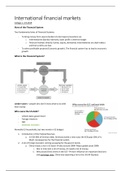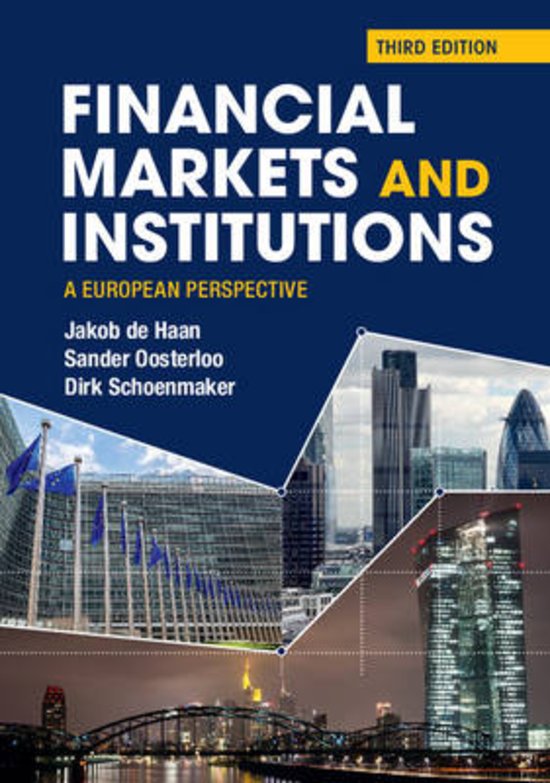International financial markets
College 1. 3-9-2019
Aims of the Financial System
Two fundamental aims of Financial Systems:
- To bring money from savers (lenders) to borrowers (investors) via
o Intermediaries (banks) indirectly; loans profit is interest margin
o Financial markets directly: bonds, equity, derivatives intermediaries are deal makers
and their profits are fees
- To select profitable projects (Economic growth). The financial system has to lead to economic
growth
What is the Financial System?
Lender-savers = people who don’t know what to do with
their money
Who owns the US debt?
- United states government
- Foreign investors
- FED
- Domestic investors
Normally US households, but two trends in US budget:
1. Introduction of the Federal Reserves
a. In ECB 30% of German debt, Germany builds a new road, the ECB pays 30% of it.
Much consequences for the financial system
2. A lot of foreign investors coming up paying for the govern bonds
a. China invests a lot in US bond → why around 2004? Major global event 2004:
i. War in Irak costs a lot of money, US needs a lot of money.
ii. Why would China invest in the US? → more influence on important decisions
and exchange rates. China was exporting a lot to the US (Ali Express).
, Increase in demand for China money and supply of dollars → appreciate
exchange rate. Exchange rate becomes more expensive for China, so it
manipulates its currency. It’s trying to depreciate it → print more money.
iii. Can they continue with this? → they can print as much money as they want
in principle.
iv. They have a lot of dollars, they sold their currency and bought dollars. What
are they going to do with these dollars? → bought a lot of US government
bonds/US debt because it gives some interest rate. A lot of demand for US
debt, overtime the longterm US interest rate went from 6% to 1 or 2%, went
down due to this plenty of money from China → Financial Crisis
b. Japan invests a lot in US bond → because of Japan has a lot of savers (cultural idea).
Interest rates in Japan are very low so investors are trying to get some sort of
interest in US bonds.
Easiest way to get economic growth in your country (example Turkey) = real estate sector (real estate
sector is borrowing a lot of money from abroad)
Main functions of financial system
Returns (and probabilities) are private information
Loan is in form of debt (limited liability)
The interest rate is 5.6%
, a) Which project has the highest return? Option 1: 8% * 0,7 + 0% * 0,3 = 5,6 expected return.
Option 2: 50% * 0,15 -5% * 0,85 = 3.25 Option 3: 11% * 0,50 + 0% * 0,50 = 5.5%
b) Which project(s) ask(s) for loan? Option 2 asks for external finance. Not option 3 because in the
most optimistic outcome they get 11% the expected outcome here is 5.5% in the most optimistic
case, they still have to pay 5.6% interest rate, 50% of getting this successful outcome, it is not
profitable to ask for external finance. Option 1. Interest rate is 5.6% and the probability of 70% * 8%
= 5.6% return. You don’t have any return as an investor if you are an entrepreneur on this project.
Option 2 is different, the probability that it will be successful is 15% * 50% = 7.5%, if it is a success the
return is 7.5% of which you have to pay 5.6% interest rate to the bank. So the investor gets 1.9%
(upside potential for investor). Debt: limited liability → bankrupt, not the cost of the investor, but
cost of the bank, that will lose its money. Option 2 will ask for a loan, for them there is upside
potential if it is a success but if it is unsuccessful they can walk away as nothing happened. The most
risky project that asks for a loan. → information asymmetry
Historically: community Finance
Main goal: Information asymmetry → Trust (Will I get my money back? Your money + interest rate).
People who are more risky, risky investment are more likey to ask for a loan.
Communities: Social capital (e.g., reputation). Social control within your community. ‘’That is a crazy
guy so don’t give him money’’. Social capital was the mechanism how trust was created.
“But the most important information that needed to be conveyed was about humans, not about lions
and bison. Our language evolved as a way of gossiping.”
Main functions of the financial system
Social capital reducing information asymmetry → When buyers and sellers have different
information, it is known as a state of asymmetric information
- Adverse selection → ex-ante, before selection of bad investors. Traders with better private
information about the quality of a product will selectively participate in trades which benefit
them the most, at the expense of the other trader.
Adverse selection refers generally to a situation in which sellers have information that buyers do
not have, or vice versa, about some aspect of product quality—in other words, it is a case where
asymmetric information is exploited. Asymmetric information, also called information failure,
happens when one party to a transaction has greater material knowledge than the other party.
- Moral hazard → ex-post, if you get a loan, that people start to behave badly. Describes the
behavioral changes that might increase the risk of loss taken because the actor will not bear
responsibility should things go wrong. Insurance industry people use to term to refer to the
possibility that after receiving coverage, a person might act in a risky way for personal gain
because the insurance company will have to cover all losses.
However, inefficiencies community finance:
- Transaction and information costs (e.g., everyone has to monitor) → if you borrow money
to another person, you have to monitor him, this costs a lot of money.
- Idiosyncratic risk → is a type of investment risk, uncertainties and potential problems that
are endemic to an individual asset. When a farmer gives one loan but there is a bad harvest,
he will lose all his money. One loan and someone default on that loan, I am also on default.
, From Community to Modern Finance
“.. societies need effective, impersonal contract enforcement, because personal ties, voluntaristic
constraints, and ostracism are no longer effective as more complex and impersonal forms of
exchange emerge” (North., 1991 p.100).
From trust in the player to trust in the game. If something goes wrong, if a company goes bankrupt
to which you borrowed money, we have trust in the government that they will enforce al the rights
and regulations that we agreed up on. The government will take care of us.
Formation of national institutions:
- Property rights
- Transparency
- Supervision
- Competition policy
Modern Financial system: Banks (indirectly) and Markets (directly)
Historically: Community Finance
However, inefficiencies community finance:
- Transaction costs: economies of scale/scope, pooling →
the bank will do this for you.
- Risk management: liquidity (liquidity transformation) → loans has become more liquid. You
can always get your money from the bank whenever you want from your deposit.
- Risk management: idiosyncratic risks to systematic risks (credit risk transformation) → risk
have decreased. Banks invest in 1000 companies, probability that they go bankrupt in the
same time is really low.
Excel file:
Standard deviation = indicator for the risk of a certain project. High risk = high standard deviation.
We are a bank and we can make a basket of these 3 projects, what will happened with the risk of
these projects?







